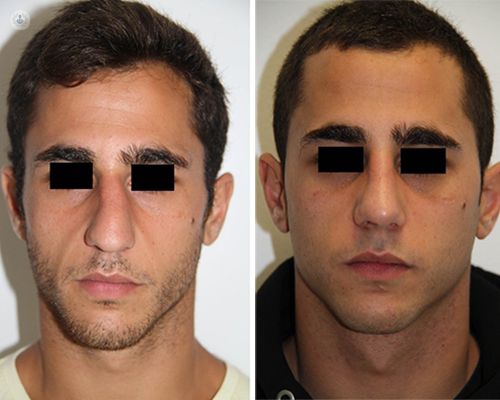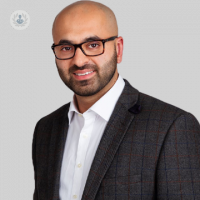Septorhinoplasty: what is it and what are the main benefits of having it done?
Autore:A septorhinoplasty is a surgical procedure aimed at making adjustments and improvements to the nose, and can result in significant improvements in appearance and breathing through the nose.
We recently spoke to revered consultant ENT and rhinoplasty surgeon, Mr Ali Qureishi, to find out more about just how beneficial this procedure can be for patients, what the procedure entails, as well as what patients should avoid immediately after undergoing the nose-transforming procedure.

What is a septorhinoplasty and what does it help to treat?
A septorhinoplasty is a surgical procedure, which is also known as a ‘nose job’. It is an operation that can be done for cosmetic purposes, to improve the appearance of the nose, and can also be performed to improve the breathing.
In my practice, it is usually a combination of both and is an operation that is usually performed under a general anaesthetic, so the patient will be put to sleep. It is normally done as a day-case procedure.
The operation time can range between two hours to three and a half hours in most cases and can be performed with or without a scar at the bottom of the nose. This depends on the reasons for the surgery and the type of problem that is being addressed.
For patients that have an incision or a scar, it is usually located at the base of the nose in the area known as the columella, which is the midline just above the lip. The scar is very well-hidden and heals extremely well, and in most patients, it is almost completely invisible.
What are the main benefits of undergoing a septorhinoplasty procedure?
Patients that undergo a septorhinoplasty can be some of the most grateful patients of all the patients that I treat, because it can help with many aspects of their breathing, whilst it can also positively affect their exercise, sense of smell, sense of taste, sleep quality, and day-to-day general well-being.
The cosmetic aspects of the septorhinoplasty operation can also be very beneficial to patients who feel the need to address any deformities that may have occurred due to trauma, or any area that they have been very self-conscious about for a very long period of time.
What can happen if a deviated septum is left untreated?
For some patients who have a deviated septum, there may not be any symptoms early on, but as they age, they may start to find or notice some problems with their breathing, particularly on one side, which can be most noticeable when they are lying down.
Otherwise, patients who have symptomatic deviated septums will usually have problems with breathing which can affect exercise, and can also affect their breathing at night, which can lead to dry mouth and even snoring.

What happens during a typical septorhinoplasty procedure?
For ‘closed’ septorhinoplasty operations, all the cuts or surgical incisions are placed on the inside of the nose, then the areas that are deviated or crooked can be straightened, either by removing the tissue and reimplanting it or by placing special stitches.
In some patients, the bones need to be broken and realigned to straighten a bent nose or remove a hump. This can often be done with no scars on the face to try to improve the profile view. In a handful of scenarios, this needs to be done with an open approach and a small incision needs to be placed at the bottom of the nose, which allows the skin to be stretched.
By doing so, the surgeon is able to look at the entire structures of the inside of the nose and refashion them, before replacing the skin over the top. This procedure allows for greater remodelling to take place and is often preferrable in patients who are having a lot of work done to change the shape of the nasal tip, completely rebuild the nasal septum or in revision surgery when there is a lot of scar tissue.
Are there certain things that people should avoid doing following a septorhinoplasty?
Yes, absolutely. One of the main things that I really discourage for patients having any surgery, particularly cosmetic surgery to their nose, is smoking. It is really important to try to avoid that because it affects the blood supply to the tissues in the nose and affects the healing quality.
The other thing that all patients must do after a septorhinoplasty is to take at least two weeks off from their normal work to allow themselves to sleep and rest and let the swelling settle down.
For the first 24 to 48 hours after a septorhinoplasty surgery, is it very good and highly recommended to sleep slightly propped up, which allows the nose swelling to settle down. Patients should avoid any heavy lifting, and keep their nose above the level of their heart, as excessive bending or straining can cause the nose to bleed.
Exercise is also something that patients should avoid for the first two weeks after surgery. After this, then they can start doing light exercise. After about four to five weeks, patients can engage in almost all of their physical activities that they engaged in prior to surgery, even swimming.
Patients should of course also be extremely careful with contact sports, as their nose will always be susceptible to breaking.
Mr Ali Qureishi is a highly esteemed consultant ENT otolaryngologist and rhinoplasty surgeon who specialises in septorhinoplasty, as well as many other nose-related treatments and conditions. If you are considering undergoing a septorhinoplasty, you can consult directly with Mr Qureishi by visiting his Top Doctors profile today.


